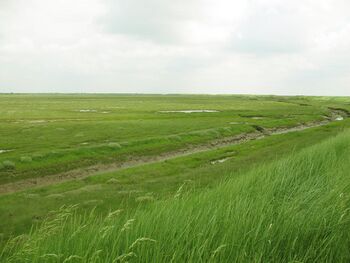Managed retreat
Topic: Earth
 From HandWiki - Reading time: 7 min
From HandWiki - Reading time: 7 min
Managed retreat involves the purposeful, coordinated movement of people and buildings away from risks. This may involve the movement of a person, infrastructure (e.g., building or road), or community. It can occur in response to a variety of hazards such as flood, wildfire, or drought. Politicians, insurers, and residents are increasingly paying attention to managed retreat from low-lying coastal areas because of the threat of sea level rise due to climate change.[1] Trends in climate change predict substantial sea level rises worldwide, causing damage to human infrastructure through coastal erosion[2] and putting communities at risk of severe coastal flooding.[3]
The type of managed retreat proposed depends on the location and type of natural hazard,[4][5][6] and on local policies and practices for managed retreat. In the United Kingdom, managed realignment through removal of flood defences is often a response to sea-level rise exacerbated by local subsidence. In the United States, managed retreat often occurs through voluntary acquisition and demolition or relocation of at-risk properties by government.[7][8] In the Global South, relocation may occur through government programs.[9] Some low-lying countries, facing inundation due to sea-level rise, are planning for the relocation of their populations, such as Kiribati planning for "Migration with Dignity".[10]
Managed realignment
In the United Kingdom, the main reason for managed realignment is to improve coastal stability, essentially replacing artificial 'hard' coastal defences with natural 'soft' coastal landforms.[11] According to University of Southampton researchers Matthew M. Linham and Robert J. Nicholls, "one of the biggest drawbacks of managed realignment is that the option requires land to be yielded to the sea."[12][unreliable source?] One of its benefits is that it can help protect land further inland by creating natural spaces that act as buffers to absorb water or dampen the force of waves.
Managed realignment has also been used to mitigate for loss of intertidal habitat. Although land reclamation has been an important factor for salt marsh loss in the UK in the past,[13] the majority of current salt marsh loss in the UK is believed to be due to erosion.[14] This erosion may involve coastal squeeze, where protective sea walls prevent the landward migration of salt marsh in response to sea level rise when sediment supply is limited.[14][15] Salt marshes are protected under the EU Habitats Directive as well as providing habitat for a number of species protected by the Birds Directive (see Natura 2000). Following this guidance, the UK's biodiversity action plan aims to prevent net losses to the area of salt marsh present in 1992. It is, therefore, a legal requirement that all losses in marsh area must be compensated by replacement habitat with equivalent biological characteristics.[16] This equates to the need to restore approximately 1.4 km2 of salt marsh habitat per year in the UK. One of the major reasons cited for the slow pace of current salt marsh restoration in the UK[14] is the uncertainty associated with the practice (Foresight).
There are no agreed protocols on the monitoring of managed realignment sites[17] and, consequently, very few of the sites are being monitored consistently and effectively.[18] Due to the low levels of monitoring there is little evidence on which to base future managed realignment projects. This has led to the results of managed realignment schemes being extremely unpredictable.
Relocation programs
Managed retreat in the form of relocation has been used in inland and coastal areas in response to severe flooding and hurricanes. In the United States, this often takes the form of "buyout" programs, in which government acquires and relocates or demolishes at-risk properties.[7][19] In some cases, individual homes are purchased after disasters.[20] In other cases, such as Odanah[21] and Soldiers Grove, Wisconsin,[22] or Valmeyer, Illinois,[23] or Isle de Jean Charles, Louisiana the entire community has relocated.
Managed retreat can be very controversial.[24] A lawsuit in Del Mar California brought on by residents was initiated to stop a managed retreat program based on worries that home values, insurance costs and restricted home expansion have been effects of the policy.[25] Some areas included in managed retreat are above sea level and are recommended based primarily on estimated engineering costs and by studies financed by the California Coastal Commission itself.[26][27][28]
Despite the controversy, as the costs of climate change adaptation increase, more communities are beginning to consider managed retreat.[29] One such community is Marina, California, adjacent to Monterey Bay. Marina's general acceptance of managed retreat became the subject of a Los Angeles Times feature article, published in 2020.[30]
Realignment examples
In the UK, the first managed retreat site was an area of 8,000 square metres (86,000 sq ft) at Northey Island in Essex flooded in 1991, followed by larger sites at Tollesbury and Orplands (1995), Freiston Shore (2001) and Abbott's Hall Farm, at Great Wigborough in the Blackwater Estuary, it is one of the largest managed retreat schemes in Europe. It covers nearly 280 hectares (690 acres) of land on the north side of the estuary (2002) and a number of others. The programme was started by the Essex Wildlife Trust (EWT) who own Abbott's Hall Farm. They made five breaches in the original old sea wall to allow the held-back sea to flood through to create salt marshland. The marshland over time reverted to its original state before cultivation, providing excellent bird habitat and breeding grounds.[31][32]
Forced retreat under climate change
As a result of two climate change related landslides in New Zealand in 2005, the Whakatāne District Council began to plan for climate-related migration to the Matatā township over the next decade. The vast majority of residents accepted the need to relocate and did so with council assistance and compensation but (As of October 2021) one resident has rejected both the process and the need to move and is now the neighbourhood's sole remaining occupant. NIWA coastal hazards expert Rob Bell says the issue of retreat is primarily socio-political rather than technocratic.[33]
See also
- Biology:Restoration ecology – Scientific study of renewing and restoring ecosystems
- Social:Environmental migrant – People forced to leave their home region due to changes to their local environment (an involuntary, forced case)
- Medicine:Space and survival – Idea that long-term human presence requires to be spacefaring (a hypothetical extreme case in science fiction)
References
- ↑ Kool, Rick; Lawrence, Judy; Drews, Martin; Bell, Robert (2020-11-01). "Preparing for Sea-Level Rise through Adaptive Managed Retreat of a New Zealand Stormwater and Wastewater Network" (in en). Infrastructures 5 (11): 92. doi:10.3390/infrastructures5110092. ISSN 2412-3811.
- ↑ Leatherman, S. P., Zhang, K., & Douglas, B. C. (2000). Sea level rise shown to drive coastal erosion. Eos, Transactions American Geophysical Union, 81(6), 55-57.
- ↑ Vitousek, S., Barnard, P. L., Fletcher, C. H., Frazer, N., Erikson, L., & Storlazzi, C. D. (2017). Doubling of coastal flooding frequency within decades due to sea-level rise. Scientific reports, 7(1), 1-9.
- ↑ Greiving, Stefan; Du, Juan; Puntub, Wiriya (7 November 2018). "Managed Retreat — A Strategy for the Mitigation of Disaster Risks with International and Comparative Perspectives". Journal of Extreme Events 05 (2n03): 1850011. doi:10.1142/S2345737618500112.
- ↑ Siders, A.R.; Hino, Miyuki; Mach, Katharine J. (23 August 2019). "The case for strategic and managed climate retreat". Science 365 (6455): 761–763. doi:10.1126/science.aax8346. PMID 31439787. Bibcode: 2019Sci...365..761S.
- ↑ Hino, Miyuki; Field, Christopher B.; Mach, Katharine J. (May 2017). "Managed retreat as a response to natural hazard risk". Nature Climate Change 7 (5): 364–370. doi:10.1038/nclimate3252. Bibcode: 2017NatCC...7..364H.
- ↑ 7.0 7.1 Mach, Katharine J.; Kraan, Caroline M.; Hino, Miyuki; Siders, A. R.; Johnston, Erica M.; Field, Christopher B. (1 October 2019). "Managed retreat through voluntary buyouts of flood-prone properties". Science Advances 5 (10): eaax8995. doi:10.1126/sciadv.aax8995. PMID 31633030. Bibcode: 2019SciA....5.8995M.
- ↑ Siders, A.R. (October 2019). "Managed Retreat in the United States". One Earth 1 (2): 216–225. doi:10.1016/j.oneear.2019.09.008. Bibcode: 2019OEart...1..216S.
- ↑ Ajibade, Idowu (2 September 2019). "Planned retreat in Global South megacities: disentangling policy, practice, and environmental justice". Climatic Change 157 (2): 299–317. doi:10.1007/s10584-019-02535-1. Bibcode: 2019ClCh..157..299A.
- ↑ McNamara, Karen E (May 2015). "Cross-border migration with dignity in Kiribati". https://www.fmreview.org/climatechange-disasters/mcnamara. "The 'migration with dignity' policy is part of Kiribati's long-term nation-wide relocation strategy."
- ↑ Pethick, J. (2002). Estuarine and tidal wetland restoration in the United Kingdom: policy versus practice. Restoration Ecology, 10(3), 431-437.
- ↑ Linham, Matthew M.; Nicholls, Robert J.. "Managed Realignment". http://www.climatetechwiki.org/content/managed-realignment#Disadvantages%20of%20the%20technology.
- ↑ Allen, J. R. L., & Pye, K. (1992). Coastal saltmarshes: their nature and importance. Saltmarshes: Morphodynamics, conservation and engineering significance, 1-18.
- ↑ 14.0 14.1 14.2 Morris, R. K. A.; Reach, I. S.; Duffy, M. J.; Collins, T. S.; Leafe, R. N. (2004). "On the Loss of Saltmarshes in South-East England and the Relationship with Nereis diversicolor". Journal of Applied Ecology 41 (4): 787–791. doi:10.1111/j.0021-8901.2004.00932.x.
- ↑ Hulme, Philip E. (28 September 2005). "Adapting to climate change: is there scope for ecological management in the face of a global threat?". Journal of Applied Ecology 42 (5): 784–794. doi:10.1111/j.1365-2664.2005.01082.x.
- ↑ Crooks et al. 2001[full citation needed]
- ↑ Atkinson, Philip W.; Crooks, Steve; Drewitt, Allan; Grant, Alastair; Rehfisch, Mark M.; Sharpe, John; Tyas, Christopher J. (2004-09-23). "Managed realignment in the UK–the first 5 years of colonization by birds". Ibis 146 (146): 101–110. doi:10.1111/j.1474-919X.2004.00334.x.
- ↑ Wolters, Mineke; Garbutt, Angus; Bakker, Jan P. (May 2005). "Salt-marsh restoration: evaluating the success of de-embankments in north-west Europe". Biological Conservation 123 (2): 249–268. doi:10.1016/j.biocon.2004.11.013.
- ↑ Freudenberg, Robert (2016). Buy-in for buyouts: The case for managed retreat from flood zones. Cambridge, MA: Lincoln Institute for Land Policy. ISBN 978-1-55844-354-9. OCLC 1078995484. https://www.lincolninst.edu/publications/policy-focus-reports/buy-in-for-buyouts.[page needed]
- ↑ Binder, Sherri Brokopp; Greer, Alex (28 December 2016). "The Devil Is in the Details: Linking Home Buyout Policy, Practice, and Experience After Hurricane Sandy". Politics and Governance 4 (4): 97. doi:10.17645/pag.v4i4.738.
- ↑ Hersher, Rebecca (August 15, 2018). "Wisconsin Reservation Offers A Climate Success Story And A Warning". NPR. https://www.npr.org/2018/08/15/632335735/wisconsin-reservation-offers-a-climate-success-story-and-a-warning.
- ↑ FEMA, Village Locals Reflect Moving Was Best Flood Protection
- ↑ Elam, Stephanie. "A flood forced this town to move. It could be a model for others hit by the climate crisis". CNN. https://www.cnn.com/2019/07/17/us/valmeyer-flooding-climate-crisis-midwest/index.html.
- ↑ Koslov, Liz (2 May 2016). "The Case for Retreat". Public Culture 28 (2 79): 359–387. doi:10.1215/08992363-3427487.
- ↑ "Del Mar stands firm against 'planned retreat'". San Diego Union-Tribune. 22 May 2018. https://www.sandiegouniontribune.com/communities/north-county/sd-no-retreat-wording-20180521-story.html.
- ↑ Local Assistance Grant Program, California Coastal Commission
- ↑ San Diego Union Tribune Article "Del Mar stands firm against 'Planned Retreat'"
- ↑ "ESA Cost Benefit Presentation "Cost Benefit Analysis Methodology Overview" slide 24". http://www.cityofpacifica.org/civicax/filebank/blobdload.aspx?t=41896.52&BlobID=14496.
- ↑ Gopal, Prashant (September 20, 2019). "America's Great Climate Exodus Is Starting in the Florida Keys". Bloomberg. https://www.bloomberg.com/news/features/2019-09-20/america-s-great-climate-exodus-is-starting-in-the-florida-keys.
- ↑ Xia, Rosanna (24 February 2020). "Most California cities refuse to retreat from rising seas. One town wants to show how it's done". Los Angeles Times. https://www.latimes.com/california/story/2020-02-24/marina-sea-level-rise.
- ↑ Information on Abbott's Hall from Essex Wildlife Trust
- ↑ Pictures of the Tollesbury and Orplands managed retreat sites
- ↑ McClure, Tess (29 October 2021). "Forced retreat: one New Zealand town's fate highlights coming fight over climate adaptation". The Guardian (London, United Kingdom). ISSN 0261-3077. https://www.theguardian.com/world/2021/oct/30/forced-retreat-one-new-zealand-towns-fate-highlights-coming-fight-over-climate-adaptation.
External links
- Board on Environmental Studies and Toxicology, 2001. Compensating for Wetland Losses Under the Clean Water Act
- The UK Environment Agency’s Managed Realignment Electronic Platform
- The Online Managed Realignment Guide (OMReG): A website designed to act as a 'collecting point' for information about coastal Managed Realignment and Regulated Tidal Exchange projects in the UK and Northern Europe
- Managed Coastal Retreat: A Legal Handbook on Shifting Development Away from Vulnerable Areas
- Animation explaining basic principle of Managed Realignment
 |
 KSF
KSF

